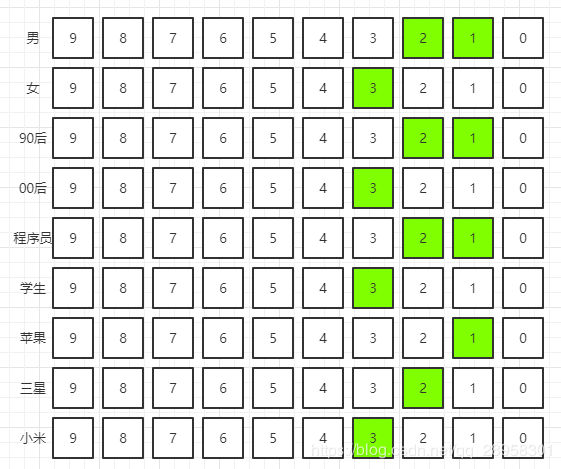漫画算法-小灰的算法之旅-算法的实际应用(六)
1. Bitmap的巧用
1.1 查询
1.2 去重
1.3 Bitmap的代码实现
2. LRU算法的应用
2.1 实例问题
2.2 代码实现
3. A星寻路算法
4. 红包算法
4.1 二倍均值法
4.2 线段切割法
1. Bitmap的巧用
Bitmap算法,又叫做位图算法,这里所说的位图并不是像素图片的位图,而是内存中连续的二进制位所组成的数据结构,该算法主要用于对大量整数做去重和查询操作。
1.1 查询
举个例子,假设给出一块长度为10bit的内存空间,也就是Bitmap,想要依次插入证书4、1、2、3,需要怎么做?
- 第1步:给出一块长度为10的Bitmap,其中的每一个bit位分别对应着从0到9的整型数。此时,Bitmap的所有位都是0;
- 第2步:把整型数4存入Bitmap,对应存储的位置就是下标为4的位置,将此bit设置为1;
- 第3步:类似第2步;
- 第4步:类似第2步;
- 第5步:类似第2步。
如果问此时Bitmap里存储了哪些元素,显然是4、3、2、1,一目了然。
1.2 去重
例如用Bitmap的形式存储用户标签,以标签为中心,一个标签对应多个用户,例如用户信息:
| ID | Name | Sex | Age | Occupation | Phone |
| 1 | 小灰 | 男 | 90后 | 程序员 | 苹果 |
| 2 | 大黄 | 男 | 90后 | 程序员 | 三星 |
| 3 | 小白 | 女 | 00后 | 学生 | 小米 |
让每一个标签存储包含此标签的所有用户ID,每一个标签都是一个独立的Bitmap:
| Sex | Bitmap |
| 男 | 1, 2 |
| 女 | 3 |
| Age | Bitmap |
| 90后 | 1, 2 |
| 00后 | 3 |
| Occupation | Bitmap |
| 程序员 | 1, 2 |
| 学生 | 3 |
| Phone | Bitmap |
| 苹果 | 1 |
| 三星 | 2 |
| 小米 | 3 |
这样一来,每一个用户特征都变得一目了然:
- 查找使用苹果手机的程序员用户:
0000000010B & 0000000110B = 0000000010B,只有ID为1的用户。
- 查找所有男性用户或00后用户:
0000000110B | 0000001000B = 0000001110B,包括ID为1、2、3的用户。
- 查找非90后的用户:
90后用户:0000000110B
全量用户(90后用户+00后用户):0000001110B
90后用户与全量用户作异或运算:
0000000110B ^ 0000001110B = 0000003000B
1.3 Bitmap的代码实现
public class MyBitmap {
private long[] words;
private int size;
public MyBitmap(int size) {
this.size = size;
this.words = new long[getWordIndex(size - 1) + 1];
}
/**
* 定位Bitmap某一位所对应的word
* @param bitIndex
* @return
*/
private int getWordIndex(int bitIndex) {
return bitIndex >> 6;
}
/**
* 把Bitmap某一位设置为true
* @param bitIndex
*/
public void setBit(int bitIndex) {
if (bitIndex < 0 || bitIndex > size - 1) {
throw new IndexOutOfBoundsException("超过Bitmap有效范围");
}
int wordIndex = getWordIndex(bitIndex);
words[wordIndex] |= (1L << bitIndex);
}
/**
* 判断Bitmap某一位的状态
* @param bitIndex
* @return
*/
public boolean getBit(int bitIndex) {
if (bitIndex < 0 || bitIndex > size - 1) {
throw new IndexOutOfBoundsException("超过Bitmap有效范围");
}
int wordIndex = getWordIndex(bitIndex);
return (words[wordIndex] & (1L << bitIndex)) != 0;
}
public static void main(String[] args) {
MyBitmap myBitmap = new MyBitmap(128);
myBitmap.setBit(126);
myBitmap.setBit(75);
System.out.println(myBitmap.getBit(126));
System.out.println(myBitmap.getBit(78));
//Java的实现类
BitSet bitSet = new BitSet(128);
bitSet.set(126);
bitSet.set(75);
System.out.println(bitSet.get(126));
System.out.println(bitSet.get(78));
}
}2. LRU算法的应用
LRU就是最近最少使用的意思,是一种内存管理算法,该算法最早应用于Linux操作系统。
这个算法基于:长期不被使用的数据,在未来被用到的几率也不大,因此,当数据所占内存达到一定阈值时,需要移除掉最近最少使用的数据。
2.1 实例问题
比如说现在需要查询用户信息,用户信息当然是存放在数据库里的,但是显然不能每一次请求时都去查询数据库,所以最直观的办法就是在内存中建立一个哈希表用于缓存用户信息,但是长期下来,由于数据增多,可能造成内存溢出,这时候就可以用到LRU算法,将最近最少使用的数据删除。
在LRU算法中,使用的一种数据结构是哈希链表。
2.2 代码实现
public class LRUCache {
private class Node {
public Node pre;
public Node next;
public String key;
public String value;
public Node(String key, String value) {
this.key = key;
this.value = value;
}
}
private Node head;
private Node end;
private int limit;
private HashMap hashMap;
public LRUCache(int limit) {
this.limit = limit;
this.hashMap = new HashMap<>();
}
private String removeNode(Node node) {
if (node == head && node == end) {
//移除唯一节点
head = null;
end = null;
} else if (node == end) {
//移除尾节点
end = end.pre;
end.next = null;
} else if (node == head) {
//移除头节点
head = head.next;
head.pre = null;
} else {
//移除中间节点
node.pre.next = node.next;
node.next.pre = node.pre;
}
return node.key;
}
private void addNode(Node node) {
if (end != null) {
end.next = node;
node.pre = end;
node.next = null;
}
end = node;
if (head == null) {
head = node;
}
}
public void put(String key, String value) {
Node node = hashMap.get(key);
if (node == null) {
//key不存在,直接插入最后
if (hashMap.size() >= limit) {
//已经满了,移除第一个节点
hashMap.remove(removeNode(head));
}
node = new Node(key, value);
addNode(node);
hashMap.put(key, node);
}
}
public String get(String key) {
Node node = hashMap.get(key);
if (node == null) {
//key不存在
return null;
}
if (node != end) {
//非尾节点移动到最后
removeNode(node);
addNode(node);
}
return node.value;
}
public static void main(String[] args) {
LRUCache cache = new LRUCache(5);
cache.put("001", "用户1");
cache.put("002", "用户2");
cache.put("003", "用户3");
cache.put("004", "用户4");
cache.put("005", "用户5");
System.out.println(cache.get("002"));
cache.put("004", "用户4更新");
cache.put("006", "用户6");
System.out.println(cache.get("001"));
System.out.println(cache.get("006"));
//Java实现类,不同之处在于更新操作也算一次使用
LinkedHashMap cache1 = new LinkedHashMap(5, 0.75f, true) {
//超出容量,删除第一个节点,默认是扩容
@Override
protected boolean removeEldestEntry(Map.Entry eldest) {
return size() > 5;
}
};
cache1.put("001", "用户1");
cache1.put("002", "用户2");
cache1.put("003", "用户3");
cache1.put("004", "用户4");
cache1.put("005", "用户5");
System.out.println(cache1.get("002"));
cache1.put("004", "用户4更新");
cache1.put("006", "用户6");
System.out.println(cache1.get("001"));
System.out.println(cache1.get("006"));
}
} 3. A星寻路算法
...
4. 红包算法
4.1 二倍均值法
假设剩余红包金额为m元,剩余人数为n,那么每次抢到的金额 = 随机区间[0.01, m / n * 2 - 0.01],保证了每次随机金额的平均值是相等的,不会因为抢红包的先后顺序而造成不公平。
这个方法虽然公平,但也存在局限性,即除最后一次外,其他每次抢到的金额都要小于剩余人均金额的2倍,并不是完全自由地随机抢红包。
4.2 线段切割法
把红包总金额想象成一条很长的线段,而每个人抢到的金额,则是这条主线段所拆分出的若干子线段。
当n个人一起抢红包时,就需要确定n-1个切割点。
因此,当n个人一起抢总金额为m的红包时,就需要做n-1次随机运算,以此确定n-1个切割点,随机的范围区间是[1, m-1]。

